Earlier last month we crossed an important milestone in the growth of Gleam – 100 paying customers in 5 months. It might not seem like many, but for us, it’s an important validation that we’re building something people get value from (and love using).
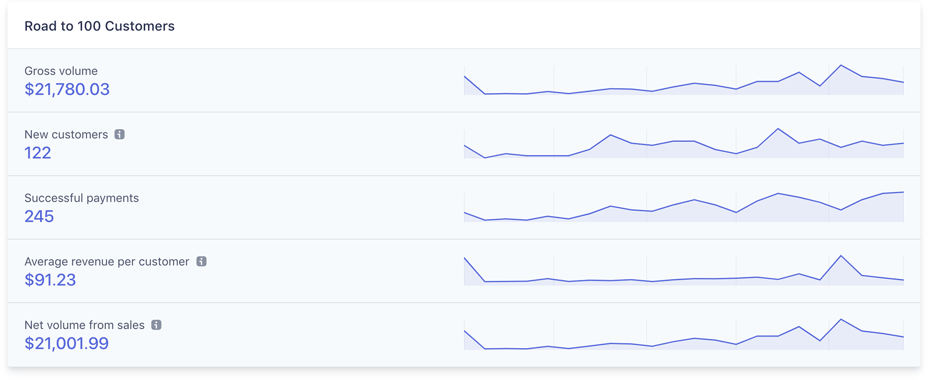
The great thing about what we’re about to show you is that we achieved this milestone without spending a cent on marketing; you could say that we growth hacked our way here, but honestly it was just months of hard work with lots of various elements all working together in various ways.
A lot of the tactics that we’ve deployed should also help us scale far beyond 100 customers, this is something you’ll be able to identify when building your own products – things like agency plans, unlimited plans & yearly plans all help you reach certain goals faster (plus also give you more capital to play with).
If you watch 1 video this month, make sure you watch this video from Microconf 2013 on bootstrapping
So, what did we do? How did we get here? You’re about to find out below. Enjoy.
This is Hard Work
Let me preface the rest of this post by saying that growing customers from a base of 0 is bloody hard work. It’s hard because there’s no magical tweak that just scales your business instantly. You need to invest time focusing on the short-term wins whilst not losing sight of the long-term gains.
Every single thing that we have tried has had some sort of overall impact to our ability to acquire more users. Positively or negatively, big or small. The more stuff you can try, the more chance you have to make an impact.


The term Do Things That Don’t Scale couldn’t be closer to the truth. If you have a limited network effect then you will have to do more & more things that don’t scale, whether it’s cold calling, emailing or networking. Remember, there’s companies (like Google) that already have the network effect but sometimes still can’t make a product work – like I said before there’s lots of factors at play here.
Reasons this is hard from a product perspective:
- You will have to deal with rejection regularly
- You won’t always make the right decisions
- You can’t make everyone happy 100% of the time (but you can try)
- Customers have more choice than ever before
- Things will always take longer than you anticipate
- Knowing what to prioritise (when there’s hundreds of things to do)
- You will have to think about things other than product: Accounting, taxes, fund raising, cashflow, expenses & much more
Reasons this is hard from a personal perspective:
- We never raised any capital (we spent 4 years saving our own seed funding)
- We both still work full time
- We’re both over 30 with families living in the 8th most expensive city in the world (Melbourne, Australia)
- Balancing family time with work time (whilst working from home) often means you’re getting less sleep
- Many of our customers (and prospects) are in completely different timezones
- John has to put up with my business reasoning & likewise I have to put up with his development reasoning. Which sometimes is harder than marriage 🙂
On the flipside, many of these network effects also have positive influences:
- Co-founders objectives are aligned, we don’t need to worry about investors
- We’re incredibly focused
- We’re in no rush, we can grow organically without worrying about outside pressures
Ask Questions
Before we even started building Gleam I emailed over 30 businesses that ran contests asking about their problems. Why did they use the platform they used? What problems or limitations did they have? What could someone do to make their life easier?
Along with our own personal drivers, we used this data to draw up an initial feature list.
- Beautifully designed widget
- 1 click actions
- Automated verification
- Facebook, Twitter, Instagram & SoundCloud
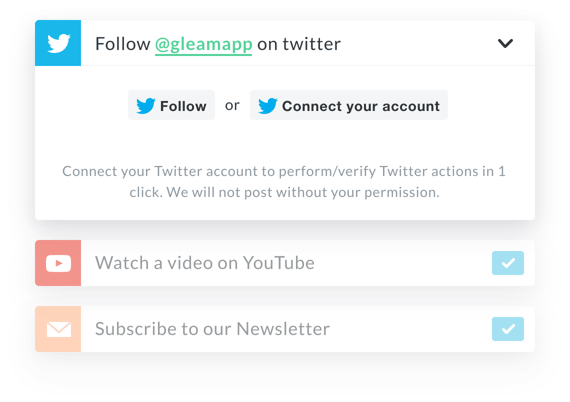
That was it. We knew people had a legitimate need for this. So we started building. Since then we’ve found that there’s lots of companies that didn’t know they had a legitimate need for something like Gleam.
Build Something Better
When you start building it is very very easy to get caught up with feature paralysis – thinking that you need to build all the features in the world to have something worth selling. If anything, it’s the opposite. You are much better building something that does one thing exceptionally well; then building on it.
Just build a great product. You could look at critical flaws in competitors & build something better, or you could focus on a problem that people have then make something that solves it beautifully.
Our initial goal was to build something that had more flexibility, more integrations & just worked. Something that was easy for businesses to build a campaign, but was also equally as easy for their customers to enter. One thing we’ve found is that you should:
You don't have to build something perfect, but your business has to do something better
Tweet This
This instantly gave us a conversation point to leverage when we started beta testing. We had different outreach approaches based on what competitor platform a business was using.
No amount of marketing can make up for a terrible product
Tweet This
Understand Your Target Markets
Once you have something worth beta testing the next step is to get users on board. This is a critical stage that enables to you:
- Validate your concept
- Build a core base of fanatical users
- Build features that people want
- Iron out bugs fast
When we had a proof of concept we emailed ~50 bloggers, offering them a free lifetime plan to help us test. This stage was critical in getting our product mature enough to start charging real money. Here’s an example of the email I used:
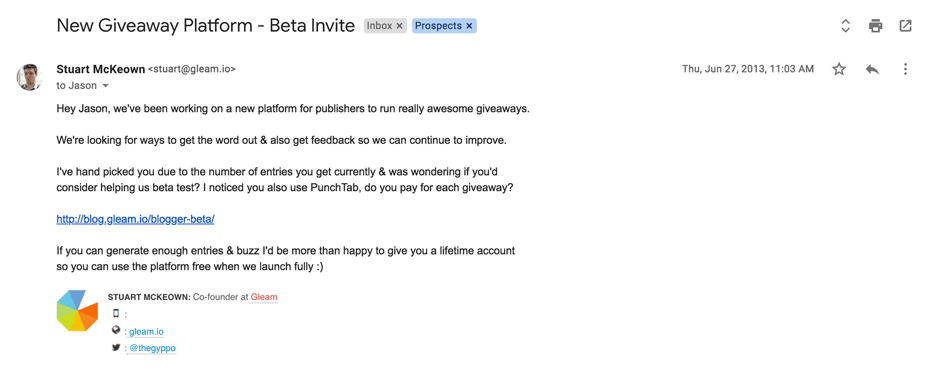
There Will be Bugs, Lots of Them
Bugs are inevitable part of building software, some users will find something that’s only triggered on a certain browser when a specific plugin is installed. The key thing is to be on top of issues. We wrote an earlier post on how we use HipChat to monitor this & fix in realtime.

In the early days, bugs actually helped drive our feature priority list. Here’s a few typical ones where the user had an issue that helped us vastly improve the product somehow (some of these features couldn’t have been anticipated):
- The widget is too wide for my blog theme: We built auto resizing down to 320px into our widget.
- You’re sending entry emails to every user for every entry: Yep this was a bit spammy, so we rolled up the entries into 10 minute increments & sent 1 email instead. We also created the option to turn off emails if they wanted.
- You had to unlike then re-like a FB page to active an entry: Fairly annoying for existing fans, so we made a quick login to auto verify those users.
- Widget was resizing strangely with lots of entry methods: We had to completely rethink how entry methods popped down. Quite a big job, but it vastly improved the user experience.
- Instagram rate limited us: Yep, that was fairly frustrating. However it meant we now have fallbacks if it happens again.
- 3rd party cookies: If you use these, you’re going to have a bad time. Quite frustrating.
- Can’t copy existing competitions: Bloggers that run a lot of contests like to copy existing ones from a template. We added this pretty quickly.
- Facebook tabs don’t work on mobile: We needed to build some smart links for users.
What we’ve found is that the more things we fix or enhance the more mature our product becomes. To the point where you may have a much more complete feature set than your closest competitors.
Send 10 Emails Every Day
Relevant outreach emails have been the single most effective ways to get customers. I set myself the task for the first 2 months to send at least 10 outreach emails every single day. I still wish I had enough time to keep doing this.
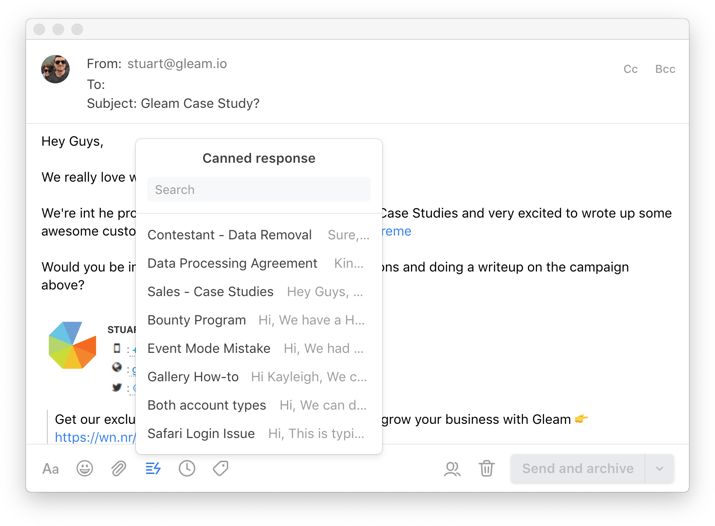
My average strike rate varied depending on the types of people I could email.
- Emailing founders: 90% response rate
- Emailing marketing team: 50% response rate
- Using contact us/feedback forms: 10% response rate
The lesson learned here is that finding the right person to email is crucial to your success. In some scenarios, I needed to Tweet to get some sort of response.
Use Social Networks to Prospect
We’re lucky that there’s quite a few specific hashtags or words that allow us to track down who is running social sweepstakes, contests or offers.
The main problem here is one that I talk about above, it’s hard to reach the right person.
I'd normally do a search on Twitter for #win or #content or #giveaway then try to track down the original Tweet from the brand:
How to Find Anyone’s Email Address
Which brings me nicely onto my next point. One of the key skills you’ll need in the early days is finding the right persons email address to contact. There’s a bit of an art to this, but here’s my process:
Find the Person You Need to Email
I’ll normally find the right person first, who is the social media manager for a company? Or who is the founder?

Once I find them, I’ll look for their name to see what social accounts they have.

The query I used above is (which you can customise):
"stuart mckeown" inurl:linkedin.com OR inurl:angel.co OR inurl:twitter.com OR inurl:facebook.com OR inurl:instagram.com
Now I need to find the actual person's email. One of the best ways to do this is to use Hunter, simply start typing in the person's name.
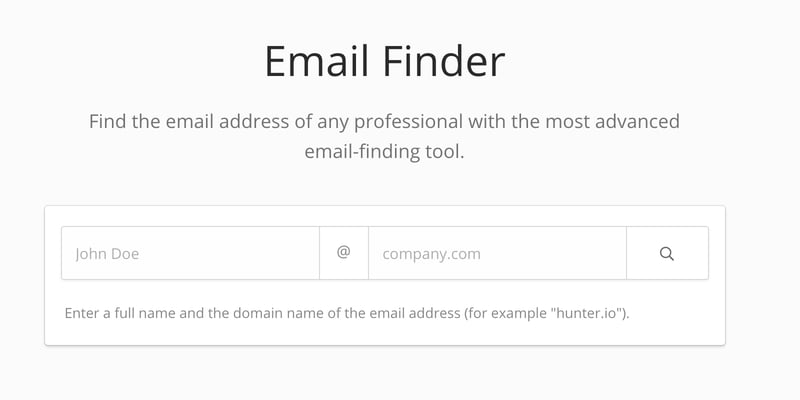
Have Customers Before You Launch
Before you fully launch you product you should already have a percentage of customers that are committed to paying you money, in our case we had approximately 10 customers who had said they’d upgrade as soon as we were ready to go. This ended up being more in the realm of ~7.
Your first 10 customers are always the hardest to acquire, then it gets much easier
Tweet This
That statement is something I’ve always held true. Once you have the steps to acquiring 10 customers, the next 10 should be easier, then the next 100 after that.
If you can reach this point before even launching to the public then it instantly makes everything easier. You know what types of customers are willing to buy your product, how much they’ll pay for it; you might even have some early advocates or case studies that can really help you propel your launch.
Do Stuff For Free
In the beginning, any interaction with a business you can get you should take it. It could turn into a case study, testimonial or better yet could help you improve your product somehow.
We did a lot of contacting users on Reddit, especially ones that were trying to grow their business. A typical exchange looked like this:
These exchanges led us to case studies, exposure on Reddit’s Startup & Entrepreneur subreddits.
Plus a few comments from customers who had also had positive experiences using the platform:

Start Charging Early
If you’re a bootstrapped business the sooner you can start charging customers the quicker you can start generating revenue, it’s a no brainer.
You should know early on whether or not people that you talk to are willing to part money to use what you’ve built. The disadvantage with this technique is that investors may want you to focus on growth & acquisition over revenue – which might delay the point at which you start charging for your product.
Whilst the final decision is up to you, consider these reasons for charging sooner:
- You set the right expectation of value around your product (i.e. it’s not free)
- Revenue allows you to do so many things, like acquisition
- Charging sooner gives you a deeper insight into the purchasing process which allows for better pricing decisions
- It gives you an indication on how many people actually are willing to pay for your product
Pricing is Hard, Focus on Value
We really struggled deciding how to price our app. We have a number of segments that typically drive value for their advertisers (therefore they don’t get much value themselves), but on the flipside we have a huge market that drives massive value from their promotions.
A typical brand could drive anywhere up to 50k actions with 1 Gleam campaign. If you think about what a typical agency might charge per action: $1.40, the value is a no-brainer.
But on the flipside, we didn’t have the time or resources to chase bigger deals, so we opted for a simple pricing structure that gave features based on the value we knew a certain type of customer would get.
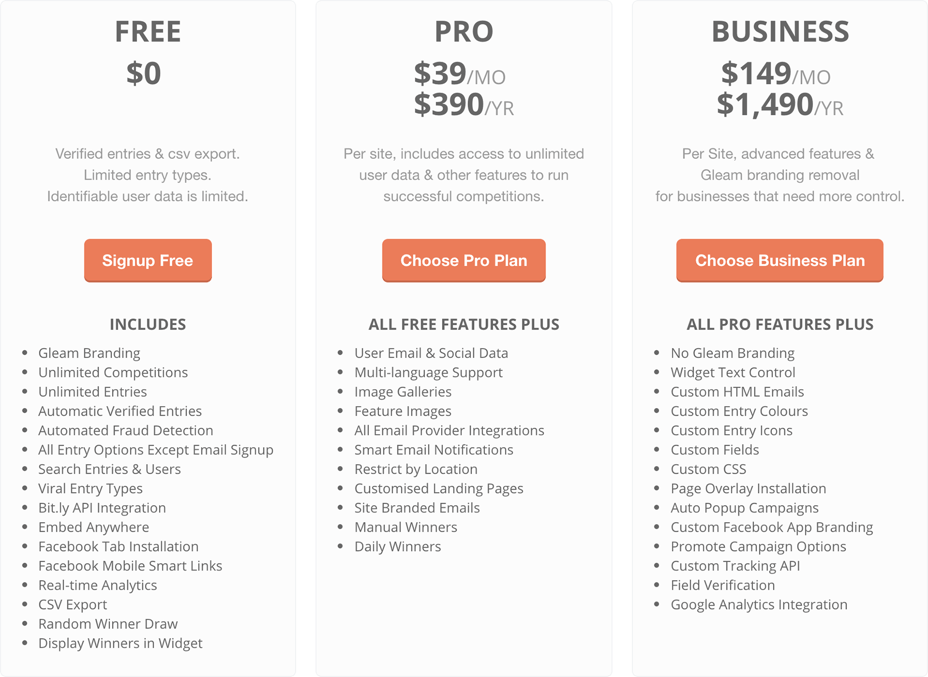
This was the original pricing we launched with, we've since updated our pricing model in early 2018
We don’t confess to have this right yet. We still get plenty of people saying your minimum plan is too expensive, we never get people on the business plan tell us that it’s too expensive. If anything, we plan to release an “Enterprise” plan.
Test calling your highest plan the Business plan. We’ve found it’s more likely to get an automatic upgrade from real businesses
Tweet This
Compare us to any other social tool on the market, most lock you in for 12 months at time, they offer no flexibility to upgrade or downgrade whenever you want. We want to make it easy to do business with us.
Customer Service is a Marketing Channel
I feel strongly that customer optimization is one of the biggest drivers of growth we have. Over 50% of users that contact us personally for support end up purchasing a paid plan. So it’s vitally important that we respond quickly, well & make them feel like we’re on top of our game.
Things I feel have helped us with customers:
- Do things FAST. Customers are always so surprised when we fix something in minutes, we love impressing them
- Personally email them (I send an intro email automatically after 24 hours which gets a 50% response rate)
- Allow them to contact you easily
- Invest in a group chatroom, we’ve been using HipChat with great results
- Always treat your customers how you would like to be treated
- Provide value, show them what to do, give them advice, show them what’s working
- Be flexible, people will want to cancel. Be fair with them, as they might come back or tell friends
If you get your customer service right, you’ll start to see your growth from word of mouth increase. I always try to ask people where they heard about us, often I’ll hear “a friend told me” or “someone mentioned you guys in a conversation”
Every interaction with a customer is the opportunity to impress them. Do it.
Tweet This
Obsess About Inbound Marketing
If you have a business you need to make time for inbound & content marketing. To me, content marketing is writing great content on your site that aligns with the types of terms that your customers might use to find you.
For us, we need to find people that want to grow their business, run social contests or engage their Facebook fans more. Over time we learned more about the types of people that were using our platform, so we started focusing more on growth hacking tips & case studies.
Over 30% of our signups come from some sort of inbound marketing activity. For example, this blog post on ways to grow your Instagram followers.
Here’s some things you can do:
- Write blog posts religiously
- Create posts that show users how to use your product
- Think about your content pillars
- Have an incredible docs area & leverage it for driving traffic
- Put presentations up on Slideshare
- Create walkthrough videos of your product & optimise for YouTube
- Build a WordPress plugin & optimise it for their directory
- Use a tool like SEM Rush to see what keywords your competitors optimise for
- Run contests to drive important actions
- Build & market to your email list
Track as Much as You Can
It’s much easier to make decisions when you have the data to support your theory. Track as much as you can:
- Site Analytics – Referral sources, conversions, segments etc
- Errors – Exceptions & Javascript errors have saved our asses so many times
- Signups / Upgrades / Downgrades – Why do they happen?
- Validation Errors – When or how are users getting fed up?
- Social mentions – Who is talking about you? Is it good or bad?
- Backlinks - Look at who's linking to you, can you build a relationship with them?
Automate Everything
If you have to do something regularly, automate it. Here’s a list of stuff we’ve automated:
- Server deployment
- Alerts for people entering our chatrooms
- Monthly payment cycles
- Fraud detection
- Lifecycle emails
- Upgrades / Downgrades
It frees up your time & helps you be consistent.
Case Studies Are Incredible
One of the most valuable things we’ve done to date is write a case study, I have no idea why we’ve only done one. But it has easily sent us over 25% of our total customers.
Users love to see real world implementations of your product, it helps to overcome objectives & shortcomings they may have in their head.
I plan to have use-case specific case studies for all our different customer types at some point.
Integration Marketing is the New Black
Strongly consider synergies that your product has with other products. We’ve successfully integrated with people like MailChimp, Campaign Monitor & Shopify. Not only has this driven sales, but it opens us instantly up to a new market of users.
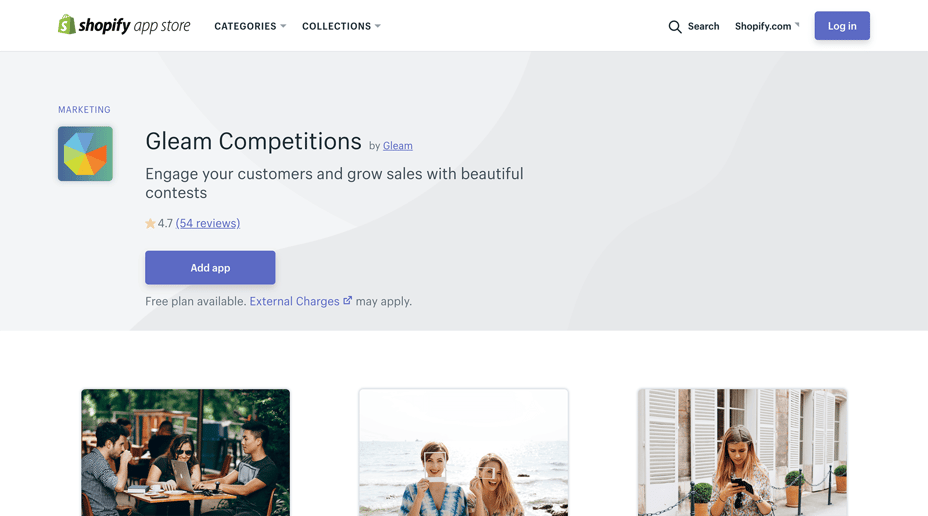
Below is a graph of an integration with FullScreen that we launched last week. This integration doubled our user base in a matter of days & gave us exposure into the YouTube & game streaming markets (i.e. Twitch).

Never Assume Something Will Work (or That it Won’t)
The best businesses are never afraid to try something different, growing your startup is no different. You’ll have plenty of conversations with co-founders, designers or developers on what everything thinks is the best way to do something.
Put this button here, make it that colours, it should have this number of steps & we should definitely be using a rotating carousel on the homepage.
If you want to make changes you should be testing what is & isn’t working. If something drops your metrics, then revert it, if something positively impacts your metrics then keep it. Do not let your ego get in the way be assuming an awesome idea will always work.
For example, we were a lot more bullish about the number of subscribers we would get with different opt-in forms (and exit intent forms) on this blog.
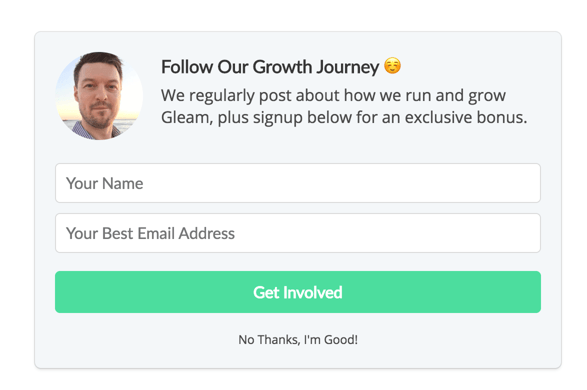
But now that we’ve tested a few variations we have a much better understanding of what works for our audience.
Freemium is a Viral Loop Tradeoff
Another 30% of our new signups (that we can track) come either directly from branding within our widgets, or from hearing or seeing one of our contests on a competitors website. Finding this viral loop is extremely important to help you build scale without having to invest as much in marketing.

Now we have to tradeoff the benefits of this exposure vs the cost of having to host & support a free user base. This is something that works well in our favour right now 🙂

